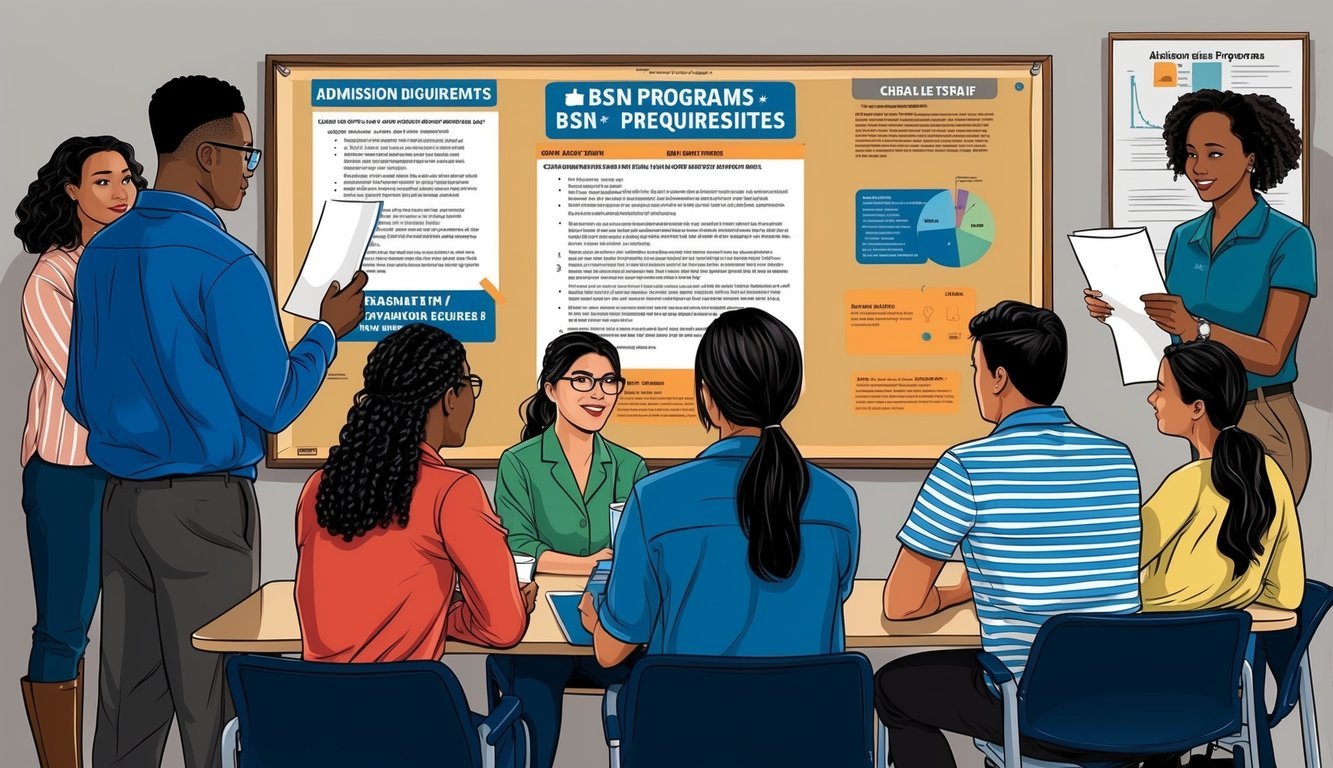Pursuing a Bachelor of Science in Nursing (BSN) opens up many exciting opportunities in the healthcare field. For those considering nursing in Texas, several top-notch BSN programs are available that can set you on the path to a rewarding career. With the state’s strong emphasis on healthcare, you can find programs tailored to meet various needs, whether you are a recent high school graduate or a working professional looking to advance.
As a prospective student, understanding the admission requirements and curriculum is vital.
BSN programs in Texas typically include comprehensive coursework and hands-on clinical experiences that prepare you for the NCLEX-RN exam.
This preparation is essential for becoming a registered nurse and making a positive impact on patient care.
Exploring financial aid options is also crucial, as many programs offer scholarships that can help reduce the cost of your education.
Taking the time to research and understand these aspects will help you make an informed decision.
Key Takeaways
- Texas offers various high-quality BSN programs suitable for different students.
- Understanding admission requirements and clinical experiences is important for success.
- Financial aid options are available to help manage education costs.
Overview of BSN Programs

BSN programs in Texas offer varied paths to achieving your nursing degree.
These programs cater to different backgrounds and career goals, making nursing accessible to many aspiring students.
Understanding the types of programs available and their accreditation status is crucial as you plan your educational journey.
Types of BSN Programs
In Texas, several types of Bachelor of Science in Nursing (BSN) programs are available to fit different needs:
-
Traditional BSN: This program typically lasts four years. It includes two years of general education and two years of nursing coursework. You can attend programs like those at the University of Texas at Austin.
-
Accelerated BSN: Designed for those who already hold a bachelor’s degree in another field, this option allows you to earn your BSN in about 12 to 18 months. Schools like Cizik School of Nursing offer this fast-paced track.
-
RN to BSN: This program is tailored for registered nurses who want to advance their education. It builds on your existing knowledge and can often be completed online, making it flexible for working professionals. The University of Texas at Arlington offers convenient online options for this track.
Accreditation
When choosing a BSN program, it’s important to consider its accreditation.
Accreditation ensures that the program meets high educational standards.
In Texas, many reputable institutions are accredited by the Commission on Collegiate Nursing Education (CCNE) or the Accreditation Commission for Education in Nursing (ACEN).
Enrolling in an accredited program can affect your eligibility for federal financial aid and ensure that your degree will be recognized by employers.
Most states require graduates to pass the National Council Licensure Examination (NCLEX-RN) to become licensed as a registered nurse.
You can check the accreditation status of programs through resources provided by NursingProcess.org.
Admission Requirements and Prerequisites

To gain admission to a Bachelor of Science in Nursing (BSN) program in Texas, you must meet specific course requirements and go through an application process.
Understanding these requirements is essential for successful admission.
Prerequisite Coursework
Before applying, you need to complete certain prerequisite courses, which often include:
| Course | Description |
|---|---|
| Biology | Typically, a general biology course is required. Some programs may specify human biology. |
| Chemistry | A general or introductory chemistry course is necessary. Look for programs that specify lab components. |
| Additional Courses | These may include courses in anatomy, statistics, and psychology. Check individual program requirements. |
Many schools recommend maintaining a GPA of 3.0 or higher in these courses to stay competitive.
You may also need to undergo a criminal background check as part of the requirements for nursing programs, which ensures the safety of future patients.
Application Process
The application process varies by institution but typically consists of several key steps:
- Submit Transcripts: You must provide transcripts from all schools attended, showing completion of prerequisite coursework.
- Entrance Exams: Schools often require standardized test scores from exams like the TEAS or HESI A2. Familiarize yourself with scoring requirements.
- Application Form: Complete the nursing program application, including personal statements and recommendations.
Take note of the deadlines—many programs, such as the one at Texas Woman’s University, have specific application periods.
Meeting these deadlines is crucial for securing your place in the program.
Each program may have unique requirements, so always verify the details on their official pages, like the University of Texas School of Nursing.
Curriculum and Clinical Experience

In a Bachelor of Science in Nursing (BSN) program, the curriculum combines essential nursing courses with hands-on clinical experiences.
These elements are crucial for preparing you for a career in nursing and ensuring you can provide quality patient care.
Core Nursing Courses
The core nursing courses form the backbone of your education.
These classes cover a range of essential topics such as:
- Fundamentals of Nursing: Basic nursing skills and patient care.
- Pharmacology: Safe medication administration and understanding drug interactions.
- Health Assessment: Techniques for evaluating patient health and recognizing issues.
- Psychiatric Nursing: Approaches to mental health care and patient communication.
These courses are designed to provide both theoretical knowledge and practical skills.
You will engage in classroom learning, group discussions, and laboratory practice, which will lay the groundwork for your clinical experiences.
Clinical Opportunities
Hands-on clinical experiences are vital for practical nursing education.
You will spend significant time in various clinical sites, applying what you’ve learned in real-world settings.
Your clinical training includes:
- Simulation Labs: These labs use high-tech mannequins for you to practice nursing skills safely.
- Patient Care Assignments: Working directly with patients allows you to refine your skills.
- Diverse Clinical Settings: Experiences may include hospitals, outpatient clinics, and community health centers.
Many BSN programs in Texas require a set number of clinical hours.
For instance, a typical program might provide around 610 clinical hours, which prepares you well for licensure.
Through these varied experiences, you will develop confidence and competence in patient care.
Preparing for the NCLEX-RN

Passing the NCLEX-RN is essential for becoming a registered nurse.
Success rates and effective study strategies play a crucial role in your preparation.
Here’s what you need to know.
NCLEX Success Rates
Understanding the NCLEX-RN success rates can motivate you during your studies.
According to the National Council of State Boards of Nursing (NCSBN), the pass rate for first-time test-takers tends to vary yearly.
| Year | Pass Rate (%) |
|---|---|
| 2020 | 88.18 |
| 2021 | 83.29 |
| 2022 | 81.61 |
These statistics show that while many succeed, others may not.
Knowing these rates can help you gauge your readiness and identify areas needing improvement.
You can access more detailed statistics on the NCSBN website for up-to-date information.
Study Strategies
Developing solid study strategies is vital for your NCLEX-RN preparation.
- Create a Study Schedule: Set aside specific times each week to focus on different subjects. Consistency helps reinforce learning.
- Practice Questions: Use NCLEX-style questions to familiarize yourself with the exam format. Resources like Kaplan or UWorld offer valuable question banks.
- Group Study: Join peers to discuss topics and quiz each other. Teaching concepts to others can deepen your understanding.
- Review Test Content: Familiarize yourself with the NCLEX Test Plan to prioritize your study topics.
Using a variety of these strategies increases retention and prepares you for the exam.
Stay focused and adjust your methods as needed to maximize your success.
Financial Aid and Scholarships
Finding financial aid and scholarships is crucial for BSN programs in Texas.
Many resources are available to help reduce your education costs.
Types of Financial Aid:
- Federal Financial Aid: Complete the FAFSA to determine your eligibility for federal grants, work-study programs, and loans.
- State Financial Aid: Texas offers various state grants for nursing students, such as the Texas Public Educational Grant (TPEG).
Scholarships:
Many universities provide specific scholarships for nursing students.
Here are some examples:
| University | Scholarship Name | Award Amount |
|---|---|---|
| Texas Woman’s University | Graduate Nursing Scholarships | Up to $330,517 |
| University of Texas Health Science Center | Cizik School of Nursing Scholarships | $1,000 to full tuition |
| University of Texas at Austin | ROTC Nursing Scholarships | Varies |
You can learn more about scholarships at the University of Texas Health Science Center or explore opportunities at the University of Texas at Austin.
Additional Resources:
- Check with your school’s financial aid office for university-specific scholarships and assistance programs.
- Look into external organizations that offer nursing scholarships to further support your education.
Frequently Asked Questions

This section provides specific answers to common questions about BSN programs in Texas.
From admission requirements to program duration, you will find helpful insights that can guide your decision-making process.
What are the top-ranked BSN programs in Texas?
Some of the top-ranked BSN programs in Texas include the programs at Texas A&M University, University of Texas at Austin, and Baylor University.
Each of these schools offers a strong nursing curriculum and is recognized for its commitment to nursing education.
What are the admission requirements for Texas A&M’s nursing program?
To apply for Texas A&M’s nursing program, you need a minimum GPA of 3.3 on a 4.0 scale.
Additionally, you must have completed all prerequisite courses with a grade of “C” or higher.
This ensures you are prepared for the rigorous nursing curriculum.
How long is the average duration of an accelerated BSN program in Texas?
The average duration of an accelerated BSN program in Texas is about 12 to 18 months.
These programs are designed for students who already hold a bachelor’s degree in another field and want to transition into nursing quickly.
Can I complete a BSN program online in Texas, and are they accredited?
Yes, many universities in Texas offer online BSN programs, and several of these programs are accredited.
Institutions like the University of Houston provide online options which the appropriate accrediting bodies recognize.
What prerequisites are generally required to apply for a nursing school in Texas?
Typically, nursing schools in Texas require applicants to complete courses in biology, chemistry, and math.
These prerequisites ensure that you have the foundational knowledge necessary for nursing education.
Each program may have specific prerequisites, so check with your chosen school.
How does the salary of a BSN-prepared nurse in Texas compare to other states?
The salary for BSN-prepared nurses in Texas generally falls in the middle range compared to other states.
On average, BSN nurses in Texas earn between $60,000 and $80,000 per year.
This average is competitive with national figures but can vary based on local demand and cost of living.

